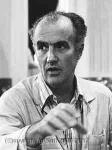Luigi Nono
Luigi Nono
Doğmuş: 1924
Ölüm: 1990
Biyografi:
Luigi Nono was an Italian avant-garde composer of classical music and remains one of the most prominent composers of the 20th century.
Nono, born in Venice, was a member of a wealthy artistic family; his grandfather was a notable painter. Nono began music lessons with Gian Francesco Malipiero at the Venice Conservatory in 1941, where he acquired knowledge of the Renaissance madrigal tradition, amongst other styles. After graduating with a degree in law from the University of Padua, he was given encouragement in composition by Bruno Maderna. Through Maderna, he became acquainted with Hermann Scherchen—then Maderna's conducting teacher—who gave Nono further tutelage and was an early mentor and advocate of his music.
Scherchen presented Nono's first acknowledged work, the Variazioni canoniche sulla serie dell'op. 41 di A. Schönberg in 1950, at the Internationale Ferienkurse für Neue Musik Darmstadt. The Variazioni canoniche, based on the twelve-tone series of Arnold Schoenberg's Op. 41, including the "Ode-to-Napoleon" hexachord, marked Nono as a committed composer of anti-fascist political orientation (Annibaldi 1980). (Variazioni canoniche also used a six-element row of rhythmic values.) Nono had been a member of the Italian Resistance during the Second World War (Schoenberg-Nono 2008). His political commitment, while allying him with some of his contemporaries at Darmstadt such as Henri Pousseur and in the earlier days Hans Werner Henze, distinguished him from others, including Pierre Boulez and Karlheinz Stockhausen. Nevertheless, it was with Boulez and Stockhausen that Nono became one of the leaders of the New Music during the 1950s.
A number of Nono's early works were first performed at Darmstadt including Tre epitaffi per Federico García Lorca (1951–53), La Victoire de Guernica (1954)—intended, like Picasso's painting, as an indictment of the wartime atrocity—and Incontri (1955). The Liebeslied (1954) was written for Nono's wife-to-be, Nuria Schoenberg (daughter of Arnold Schoenberg), whom he met at the 1953 world première of Moses und Aron in Hamburg. They married in 1955. An atheist, (Nattiez, Bent, Dalmonte, and Baroni 2001, 424) Nono had enrolled as a member of the Italian Communist Party in 1952 (Flamm 1995).
The world première of Il canto sospeso (1955–56) for solo voices, chorus, and orchestra brought Nono international recognition and acknowledgment as a successor to Webern. "Reviewers noted with amazement that Nono's canto sospeso achieved a synthesis—to a degree hardly thought possible—between an uncompromisingly avant-garde style of composition and emotional, moral expression (in which there was an appropriate and complementary treatment of the theme and text)" (Flamm 1995).
If any evidence exists that Webern's work does not mark the esoteric "expiry" of Western music in a pianissimo of aphoristic shreds, then it is provided by Luigi Nono's Il Canto Sospeso... The 32-year-old composer has proved himself to be the most powerful of Webern's successors. (Kölner Stadt Anzeiger, 26 October 1956, quoted in Flamm 1995)
This work, regarded by Swiss musicologist Jürg Stenzl (de) as one of the central masterpieces of the 1950s (Stenzl 1986b), is a commemoration of the victims of Fascism, incorporating farewell letters written by political prisoners before execution. Musically, Nono breaks new ground, not only by the "exemplary balance between voices and instruments" (Annibaldi 1980) but in the motivic, point-like vocal writing in which words are fractured into syllables exchanged between voices to form floating, diversified sonorities—which may be likened to an imaginative extension of Schoenberg's "Klangfarbenmelodie technique" (Flamm 1995, IX). Nono himself emphasized his lyrical intentions in an interview with Hansjörg Pauli (Pauli 1971, quoted in Flamm 1995, IX), and a connection to Schoenberg's Survivor from Warsaw is postulated by Guerrero 2006. However, Stockhausen, in his 15 July 1957 Darmstadt lecture, "Sprache und Musik" (published the next year in the Darmstädter Beiträge zur Neuen Musik and, subsequently, in Die Reihe), stated:
In certain pieces in the "Canto", Nono composed the text as if to withdraw it from the public eye where it has no place... In sections II, VI, IX and in parts of III, he turns speech into sounds, noises. The texts are not delivered, but rather concealed in such a regardlessly strict and dense musical form that they are hardly comprehensible when performed.
Why, then, texts at all, and why these texts?
Here is an explanation. When setting certain parts of the letters about which one should be particularly ashamed that they had to be written, the musician assumes the attitude only of the composer who had previously selected the letters: he does not interpret, he does not comment. He rather reduces speech to its sounds and makes music with them. Permutations of vowel-sounds, a, ä, e, i, o, u; serial structure.
More...
Wikipedia link: Click Here



